1. 数据简介
维基百科 link
地球静止轨道(或称地球赤道同步轨道,英语:geostationary orbit,简写:GEO)是指地球赤道面上方35,786km的圆形轨道,该轨道上航天器的运行方向和地球自转方向一致。在地球静止轨道上的航天器绕地球运行一周的时间和地球自转周期(一恒星日)相同,因此,在地面观测者看来,这样的航天器是在天空固定不动的。通信卫星和气象卫星一般运行在静止轨道,因此地面站天线只要对准卫星的定点位置就可以通讯,而不用转动天线。利用这个特点,把携带有可见光和近红外光传感器的海洋卫星发射到静止轨道上,这样就可以监测海洋环境的细微变化,比如GOCI卫星。
地球静止轨道是地球同步轨道的一个特例,二者之间有一些区别,地球同步轨道上的卫星每天在同样的时间通过地球上的同一个点,而地球静止轨道上的卫星一直固定在定点位置不动。
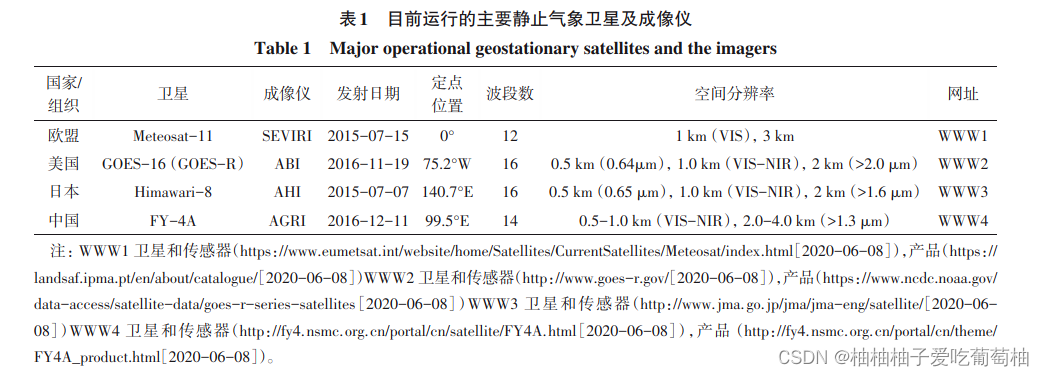
1.1 GOES-R 静止卫星
- GOES-R 系列静止气象卫星是目前NOAA 运行的最新一代静止气象卫星。该系列卫星包括GOES-R (GOES-16),GOES-S (GOES-17),GOES-T,GOES-U 等4 颗卫星,其中前两颗星分别在2016.11.19 和2018.3.1 发射运行,分别定轨在75.2°W 和137.2°W,后两颗预计在2021 年和2024 年发射(http://www. goes-r. gov/[2020-06-08])。
1.1.1 传感器
-
GOES-R 上搭载了数个传感器, 如下图所示。
-
(1) 环境类载荷包括:
– 先进基线成像仪(Advanced Baseline Imager,ABI) 、
– 同步闪电测绘仪(Geostationary Lightning Mapper,GLM)、
– 远紫外与 X 射线辐照度探测器(Extreme Ultraviolet Sensor/X-Ray Sensor Irradiance Sensors,EXIS)、
– 太阳紫外成像仪(Solar Ultraviolet Imager,SUVI)、
– 空间环境监测器/磁力仪组(SEM/Magnetometer,SEM/MAG)、
– 空间环境原位测量装置(Space Environment In-Situ Suite,SEISS)。 -
(2) 数据收集类载荷包括:
– 静止轨道搜索&救援系统(Geostationary Search andRescue System,GEOS&R)、
– 数据收集系统(DCIS)等。
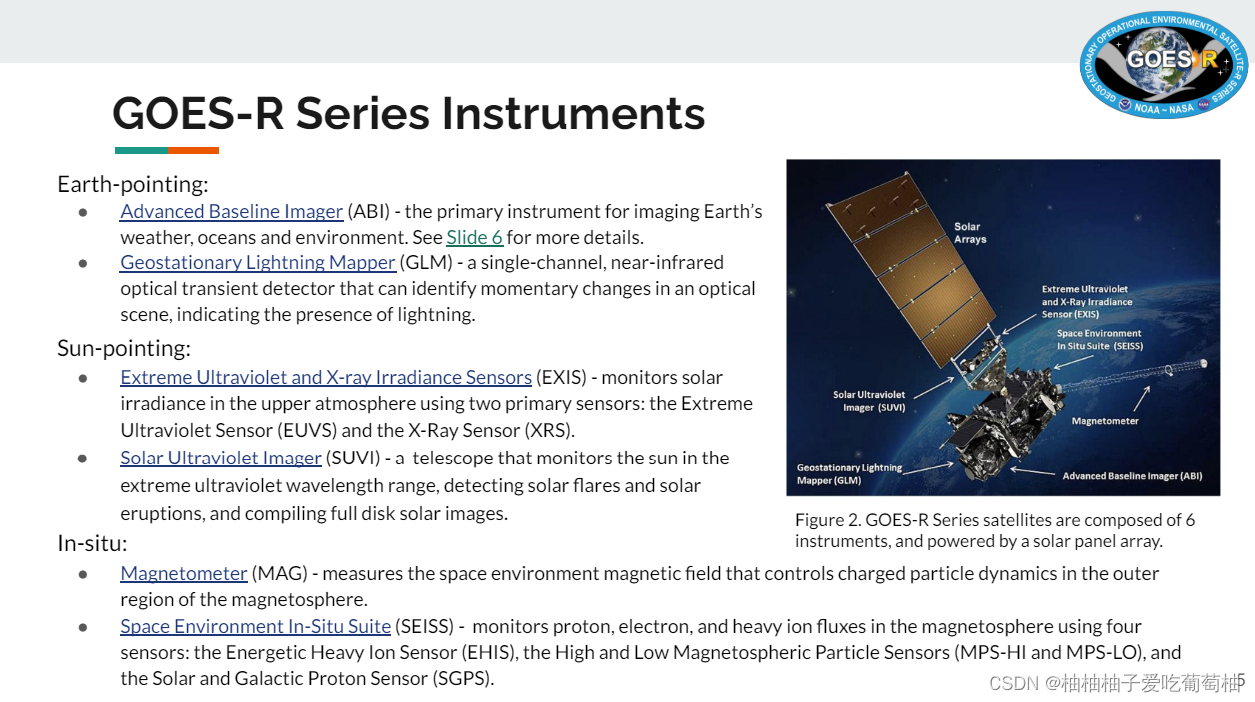
(A)高级基线成像仪(ABI)
- 其中,与陆面产品相关的传感器主要是高级基线成像仪(ABI)。ABI 有16 个波段,空间分辨率分别为0.5 km (0.64 μm),1.0 km (可见光—近红外)和2.0 km (>2 μm)(表1)。ABI有3种观测模式,分别对全圆盘(Full disk)、美国大陆(3000 km×5000 km)和中尺度区域(1000 km×1000 km)提供不同时间频率和空间分辨率的观测。时间分辨率分别为全圆盘15 min 以及美国大陆的5 min。中尺度区域观测由用户制定,提供特定感兴趣区域的高时频观测,可在30 或60 s 观测一次。
【补充:ABI 采用 3 种扫描模式对 3 类区域进行观测。3 种扫描模式分别为模式三、模式四和模式六;3 类扫描区域包括全圆盘区域(Full Disk)、美国本土区域(CONtinental United States,CONUS)以及中尺度区域(MESOs)。圆盘区域为以星下点和 ABI 中心连线为中心,ABI 对地方向以直径约 17.4的张角进行观测覆盖的地球表面区域,美国本土区域为3 000 km× 5 000 km 的长方形区域,不同的轨道位置对应的区域不同,具体如图 1 所示。中尺度区域为卫星观测区域内 1 000 km×1 000 km 大小的任意区域。
】
 【补充: ABI 不同扫描模式对应的观测区域设置及其时间见表 7,数据大小见表 8。模式三中,Full Disk:扫描时间为 15 min;CONUS:扫描时间为 5min;中尺度区域(MESOs):每个中尺度区域扫描时间(共2 个中尺度区域,每个区域 1 000 km×1 000 km)达到30 s,2 个中尺度区域同时扫描需 60 s。模式六除全圆盘区域扫描时间缩小为 10 min 以外,其他与模式三完全相同。模式四只完成 5 min 全圆盘扫描,美国本土观测模式可以从该模式全圆盘数据抽取得到。其中模式 6 为卫星系统默认观测模式。】
【补充: ABI 不同扫描模式对应的观测区域设置及其时间见表 7,数据大小见表 8。模式三中,Full Disk:扫描时间为 15 min;CONUS:扫描时间为 5min;中尺度区域(MESOs):每个中尺度区域扫描时间(共2 个中尺度区域,每个区域 1 000 km×1 000 km)达到30 s,2 个中尺度区域同时扫描需 60 s。模式六除全圆盘区域扫描时间缩小为 10 min 以外,其他与模式三完全相同。模式四只完成 5 min 全圆盘扫描,美国本土观测模式可以从该模式全圆盘数据抽取得到。其中模式 6 为卫星系统默认观测模式。】


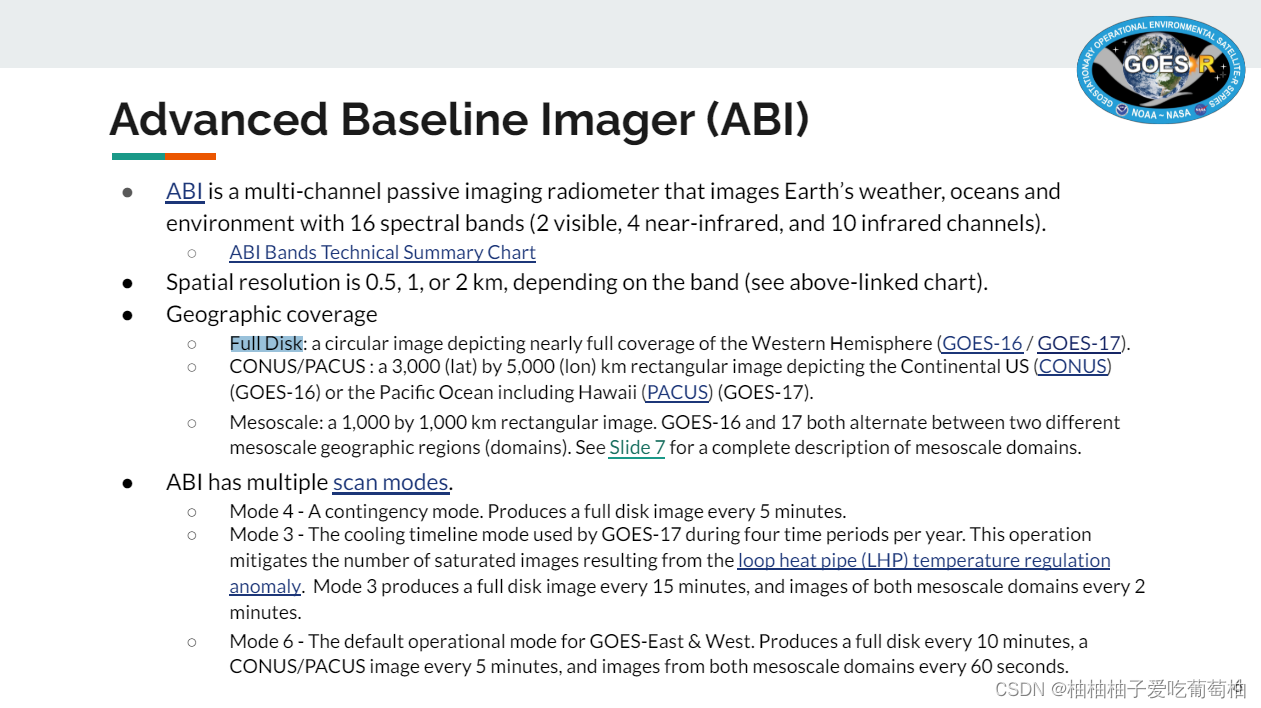
(B)地球静止轨道闪电绘图仪(GLM)
- 地球静止轨道闪电绘图仪(GLM),是一台工作在近红外谱段(777.4 nm)的 CCD 相机,空间分辨率为 8~12 km,可全天候地对发生在美国本土及近海上空的闪电进行探测和成像,补充现有陆基的测量能力。地球静止轨道闪电绘图仪能够将恶劣天气和飓风的预警时间提高到 20 min,甚至更快。GOES-16 是第一个携带闪电探测器的地球静止气象卫星。
1.1.2 标准产品
-
GEOS-R产品中主要是大气产品, 有少数地面产品。 link
-
(1)大气产品 link
-
(2)地面产品(如地表温度,下行短波辐射,火点/热点,积雪覆盖)。如:在地面产品生产过程中,需要NOAA 国家环境预报中心(NCEP)的数值天气预报数据作为辅助(https://www.ncep.noaa.gov/2020-06-08])。4 个地表产品中除了下行短波辐射是经纬度坐标,其他三个都使用格网坐标和GRS80 地球椭球体,产品格式为netCDF-4,目前产品还处于试运行阶段(provisional),可通过NOAA 综合数据中心(CLASS,https://www. class. noaa. gov[2020-06-08])或环境信息中心(NCEI,https://www. ncei. noaa.gov/products [2020-06-08])获取。

1.1.3 产品分级
- GOES-R 系列卫星产品主要包括 0 级数据、L1b数据和 L2+数据。其中 0 级数据为未经处理的原始数据;L1b 数据为经过辐射定标和地理定位后的数据,数据存储格式为 netCDF-4;L2+数据包括图像产品和定量产品,图像产品包含各个通道的云图和水汽图像,定量产品为对 L1b 数据进行环境参数反演得到的产品,以及对 L1 或 L2 数据进行时空降采样处理或者其他处理得到的数据[15-16]。各级卫星产品见表 10。
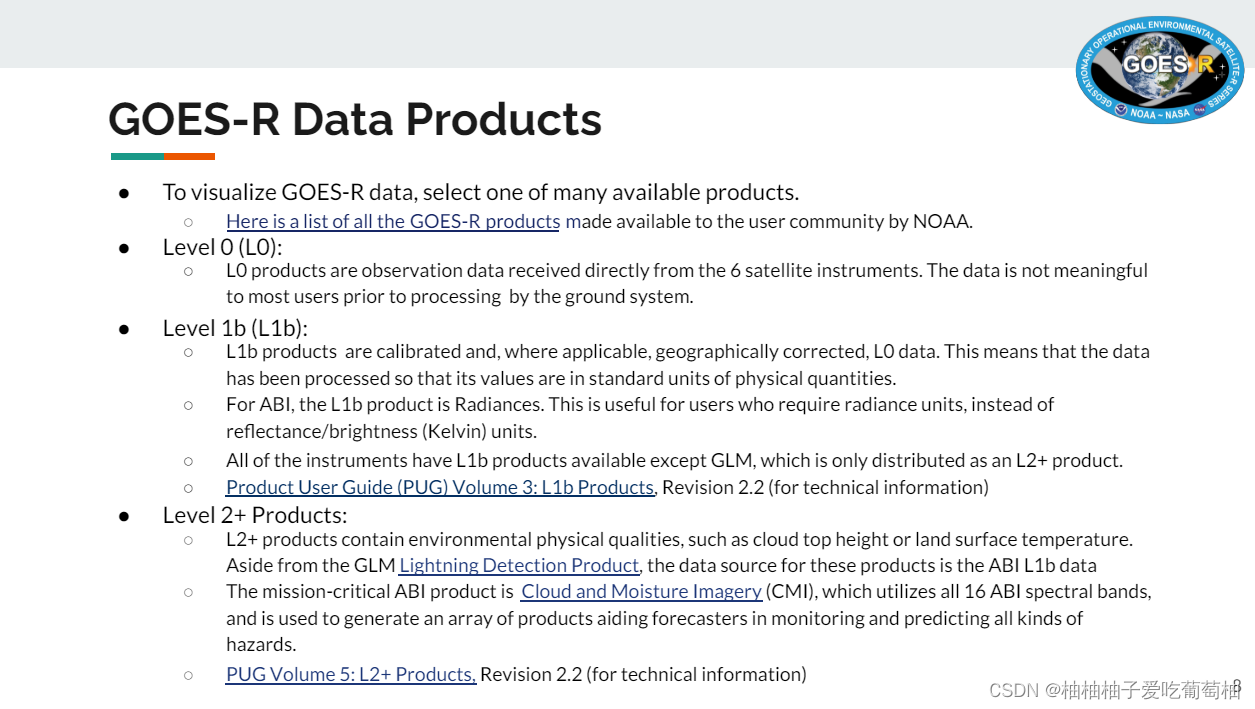
1.1.4 产品下载
产品下载的途径如下图所示 (中文教程可参考 link 和 link )
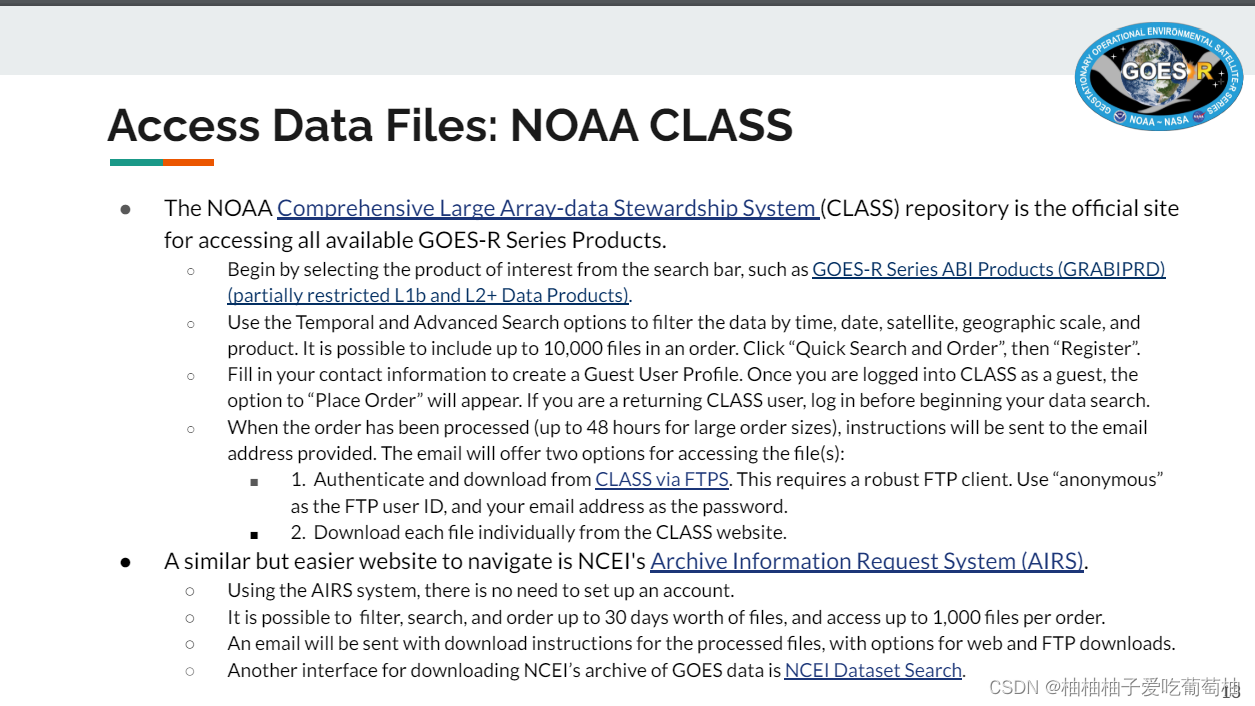
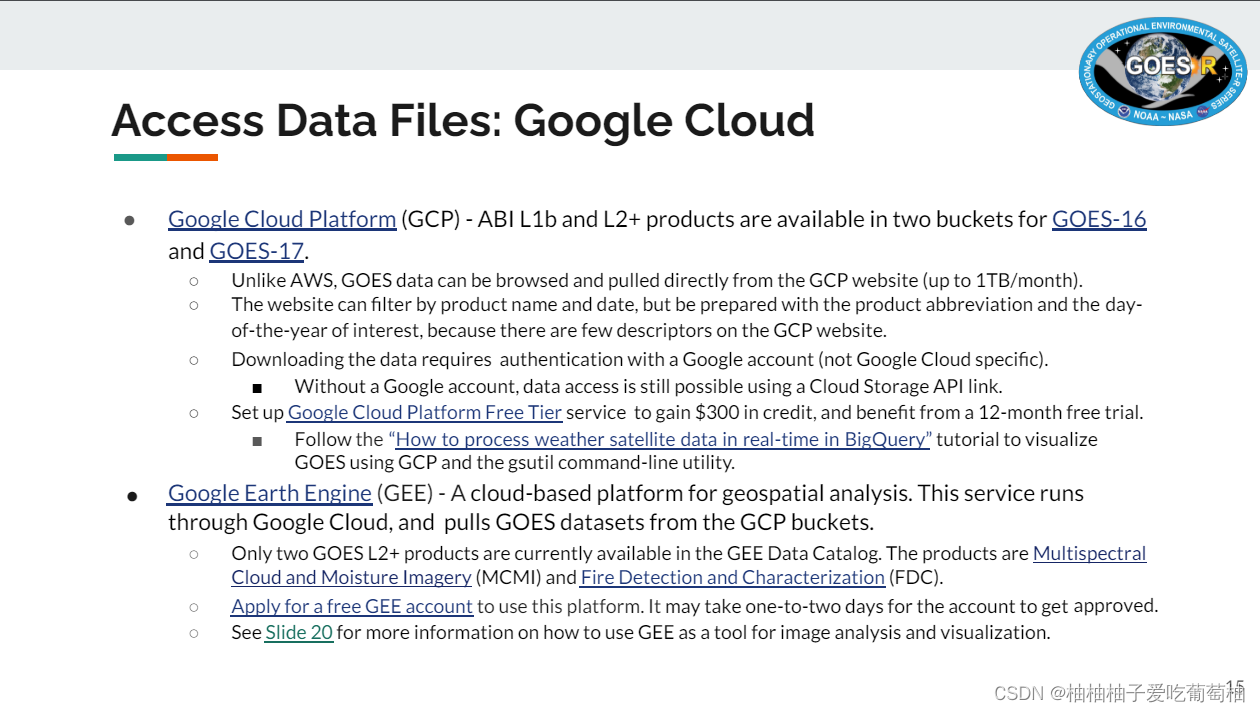
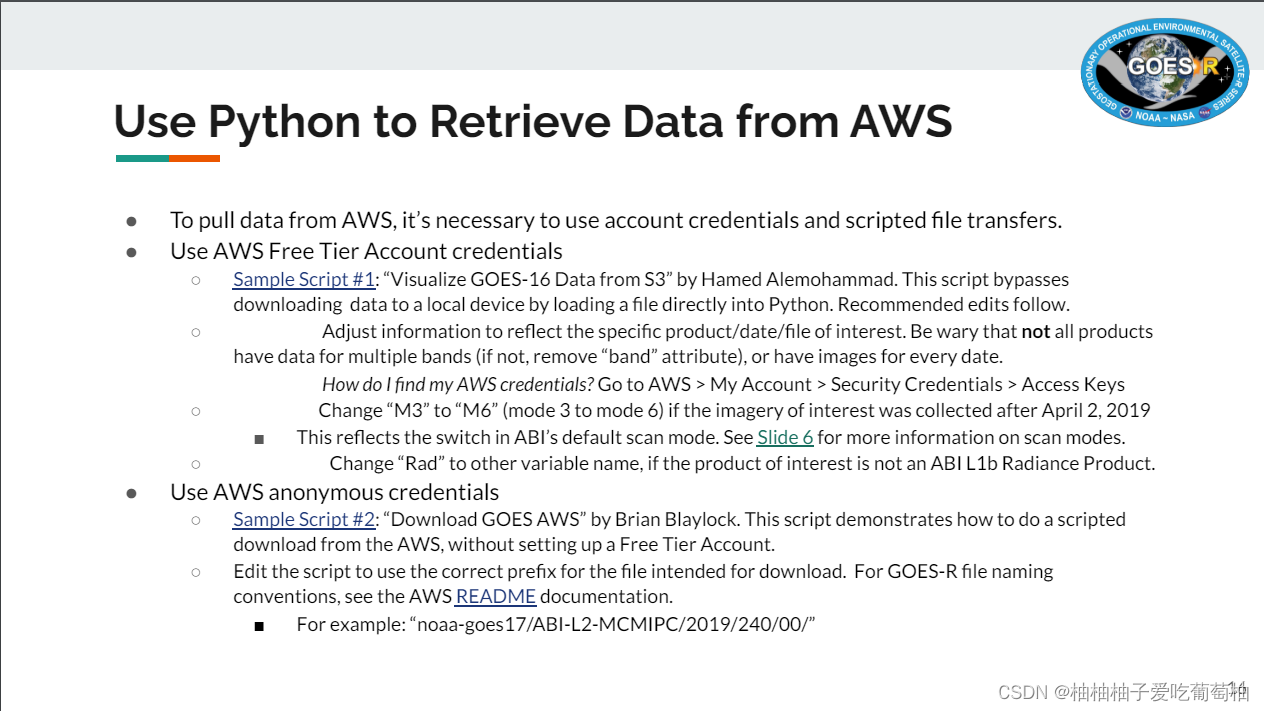
1.1.5 Geostationary-NASA Earth Exchange (GeoNEX) (GEOS16)
-
GeoNEX is a collaborative project led by scientists from NASA, NOAA, and many other institutes around the world to generate Earth monitoring products using data streams from the latest Geostationary (GEO) sensors including the GOES-16/17 Advanced Baseline Imager (ABI), the Himawari-8/9 Advanced Himawari Imager (AHI), and more.
-
GEONEX DATA PORTAL link
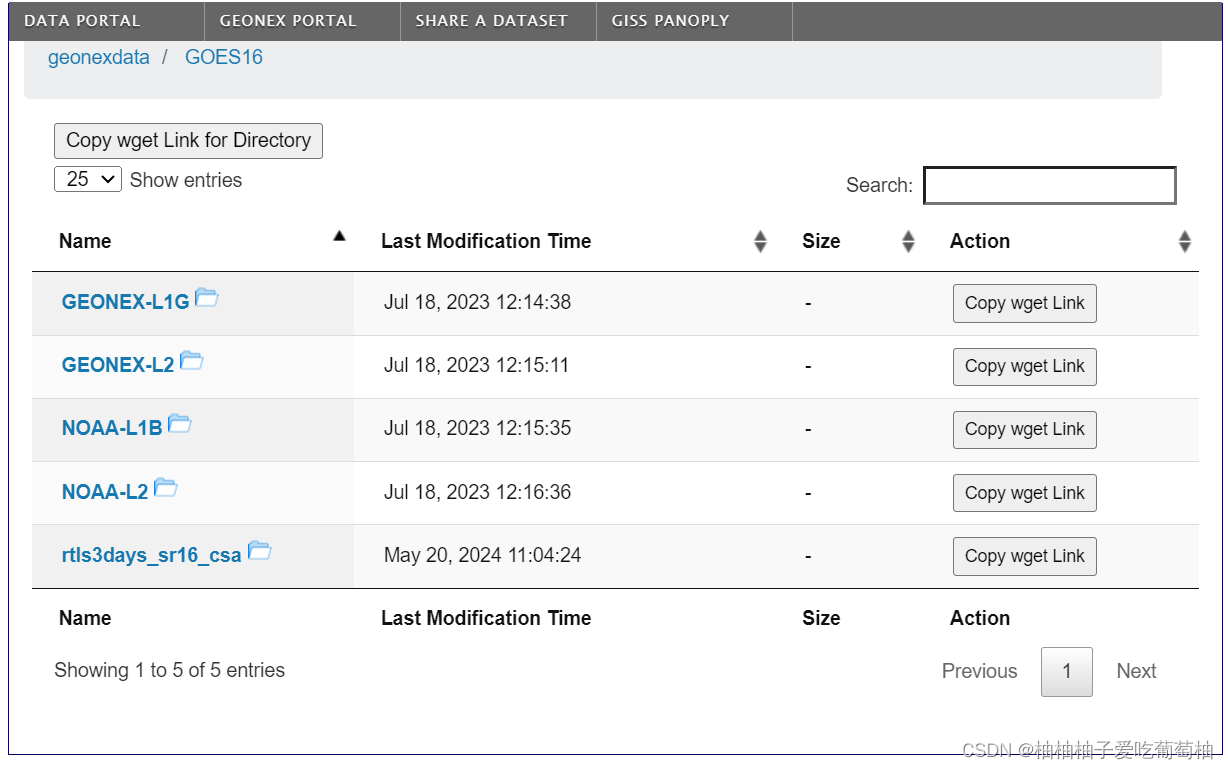
(1) DATA DIRECTORIES
-
GOES16/GEONEX-L1G/
Top-of-Atmosphere (TOA) reflectance GOES-16 ABI. This product includes the Bidirectional Reflectance Factor (BRF) for Bands 1-6 and Brightness Temperature for Bands 7-16 at the top of the atmosphere measured by the satellite sensor.
(1)BRF is defined as the ratio of the radiance reflected from the target surface (e.g., top of atmosphere) in a particular direction to the expected radiance reflected from a perfectly white Lambertian surface in the same direction under the same conditions of illumination and reflection. The phrase “bidirectional” emphasizes that the variable is a function of both solar incident and satellite-viewing angles.
(2) Brightness temperature is the temperature of a blackbody that would emit the same amount of radiation as the targeted body in a specified spectral band. It is different from the true surface temperature because (1) the surface is not a perfect blackbody; and (2) it is influenced by atmospheric conditions. For more information on the steps used to create this product see https://www.nasa.gov/geone -
GOES16/GEONEX-L2/
GOES16 surface reflectance (Surface BRF) estimated through the process of atmospheric correction for Bands 1-6.
(1)SR is calculated by removing the atmospheric influence (absorption and scattering by molecules and aerosols) from the TOA reflectance. The data are also filtered for unfavorable conditions (e.g., clouds and shadows) under which the retrieval of SR is not feasible or reliable. Intermediate products include cloud masks, atmospheric aerosol optical thickness (AOT), surface
BRDF parameters, and so on.
(2)The current surface reflectance dataset is produced with an early version of MAIAC. The accuracy of cloud detection and aerosol retrievals is not yet sufficient for science publications. We are still working on issues with the BRDF model fit and atmospheric correction.
(3)The next improved version of MAIAC is in a stage of completion, and the updated results of processing will be available the in near future. -
GOES16/NOAA-L1B/
GeoNEX GOES16 INPUTS, provided only as an convenience for exploration.
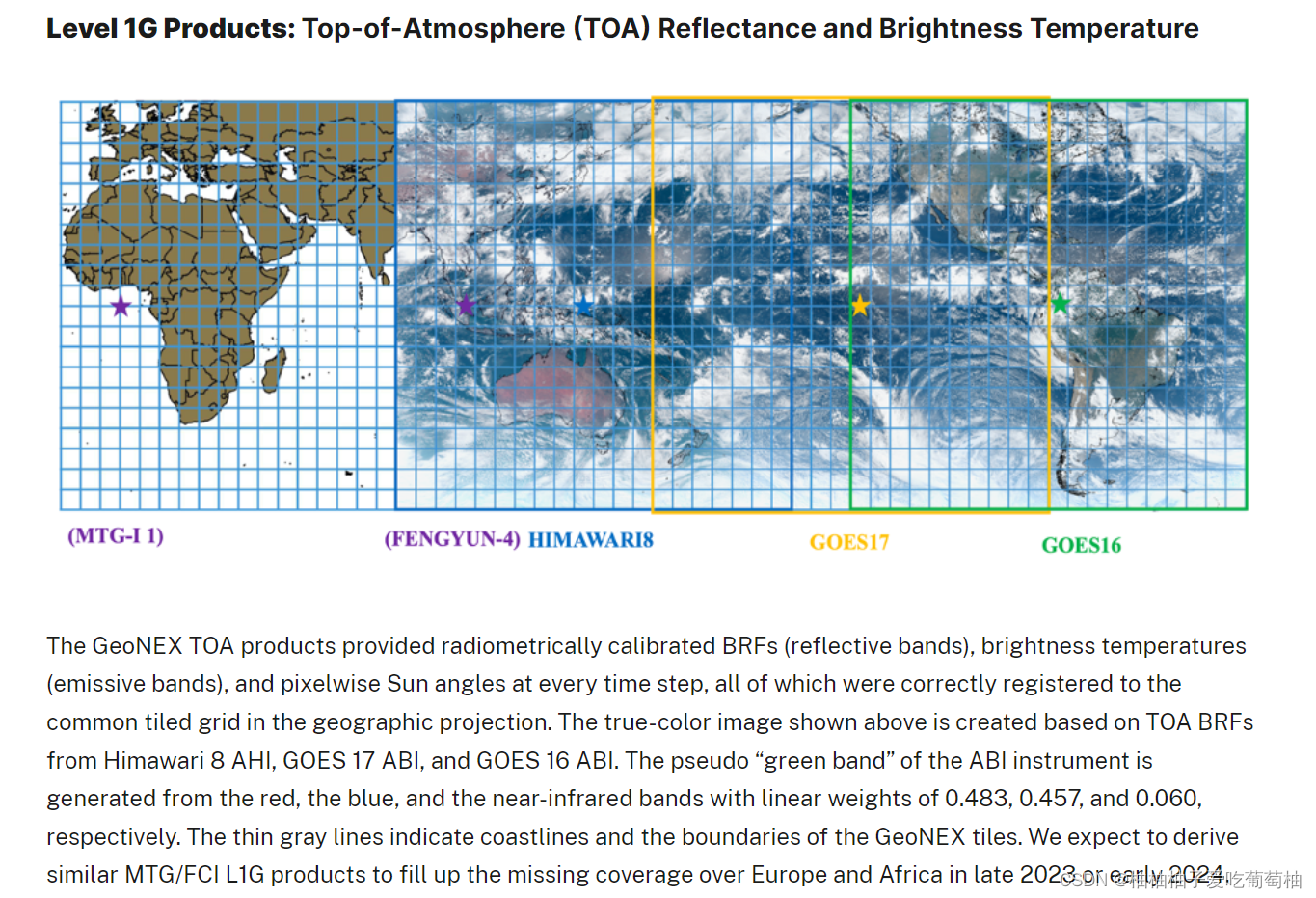
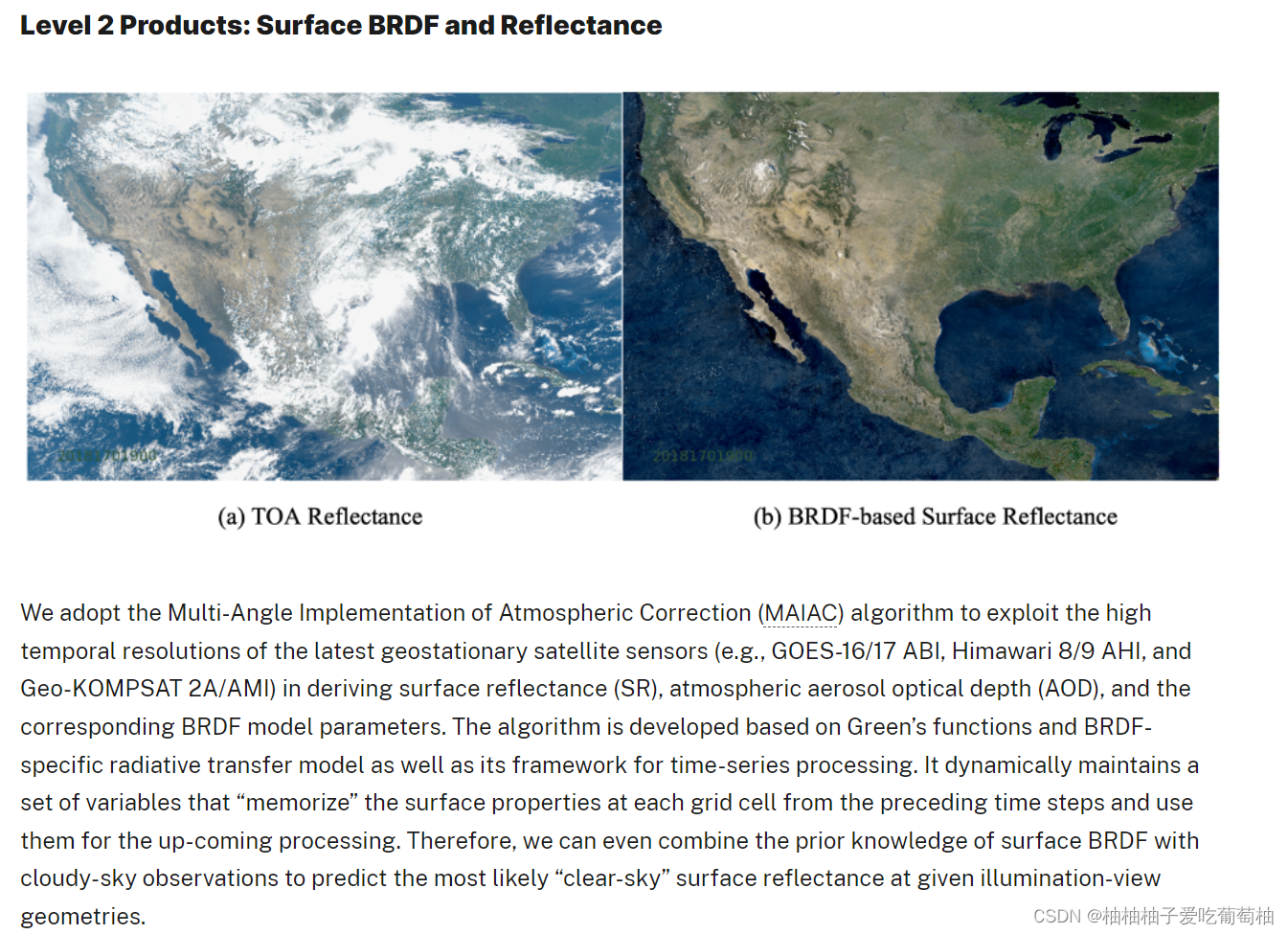
(2) FILE NAMING CONVENTIONS FOR L1G DATA
For all GeoNEX products, the following naming convention is used:
-
<Satellite/Sensor Code>
GLBG_hv.hdf -
<Satellite/Sensor Code>: HM08_AHI for Himawari 8 AHI, and GO16_ABI or GO17_ABI for GOES ABI, GK2A_AMI for GEO-KOMPSAT-2A AMI.
-
< Product ID >: A two-digit number assigned to each GeoNEX product. Currently, only the Product ID of “05” is
available, indicating “Top-of-Atmosphere Reflectance” -
< YYYYMMDD >: Year-Month-Day, e.g., 20180501
-
< HHMM>: Hour-Minute (UTC time), e.g., 2030
-
< hid >, < vid >: Horizontal or Vertical Tile ID
-
< version >: Product version code; currently “02”
Note, the input and convenience products may differ from the above naming convention.
(3) GEONEX-L1G数据介绍
- 数据生产
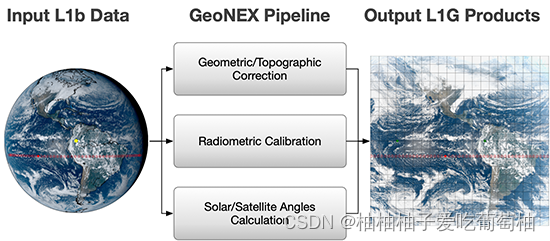
- 空间格网

参考文献
[1] 方红亮. 基于地球静止气象卫星的地表参数遥感研究进展[J]. 遥感学报, 2021, 25(1): 109-125.
[2] Beginner’s Guide to GOES-R Series Data link
[3] 张春华, 李松, 刘洪伟, 等. 美国 GOES 系列卫星的发展[J]. 装备环境工程, 2022, 19(4): 124-131.
[4] L1G and L2 data introduction link
[5] Wang W, Li S, Hashimoto H, et al. An introduction to the geostationary-NASA earth exchange (GeoNEX) products: 1. Top-of-atmosphere reflectance and brightness temperature[J]. Remote Sensing, 2020, 12(8): 1267.



)













的车牌自动识别系统(matlab))

